Reviewed by Mordechai Djavaheri
In honor of the publishing of the new volume of Yalkut Yosef – Yalkut Taharah, it’s worthwhile review the practical Niddah sefarim options to ensure we have the right books for the right reader. Rabbis and students also reach out to me periodically seeking recommendations and guidance for which Hilchot Niddah book to use for Sephardic Chattanim and Kallot.
Here are some contemporary Hilchot Niddah Seforim for Sepharadim:
Important factors to keep in mind are:
- Breadth – how comprehensive the sefer is in describing every halacha with all of its parameters spelled out as clearly as possible for every single case, as opposed to how much it’s just a book to “get by” without knowing the sugyot and their sources.
- Depth – elaboration of sources and overall explanations for why we do things. Presentation of other opinions and citations of sources.
- Shitah – views of which posek or posekim are being presented. Sepharadi and Ashkenazi, and, within Sepharadi, just one rabbi or many. Minhagim of a specific community or just “pan-Sephardic/Edot HaMizrach.”
- Languages available.
- Availability in stores.
If any readers would like to offer further information, please do so below in the comments section!
1. Taharat HaBayit
Hacham Ovadia Yosef
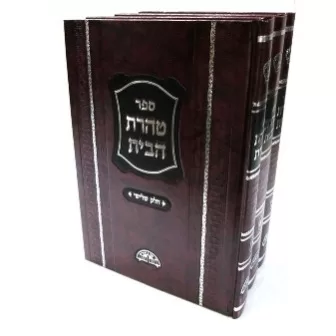
Taharat HaBayit is Hacham Ovadia’s classic three-volume compendium covering much of Hilchot Niddah with extensive footnotes in his usual style. His general style is to determine and juggle the view of Shulchan Aruch, any conflicting Minhagim, and the stance of the majority of Poskim. Stringencies are left to the individual to adopt privately: the public needs to be informed of the actual, basic halacha, and avenues for further leniency must be established for when they are warranted. The halachot on top are called “Taharat HaBayit,” and the footnotes are called “Mishmeret Taharah.”
This is not comprehensive in that it does not cover every or even most cases but rather, only a selection of major halachot in detail. Every Avrech in Kollel must own this sefer, but not people who are not going to be learning the sugyot of Niddah inside. The newest edition has shoulder notes for the footnotes and a new layer of footnotes from the glosses of his own Seforim as well as citations to his other Seforim. Before this edition was printed, someone published a sefer Ikkarei HaMishmeret, in which he summarized all the main points and conclusions borne out of the footnotes.
Rav Ovadia and sons’ Seforim are readily available in Seforim stores.
2. Torat HaTaharah / Taharat HaBayit HaKatzar
Hacham David Yosef
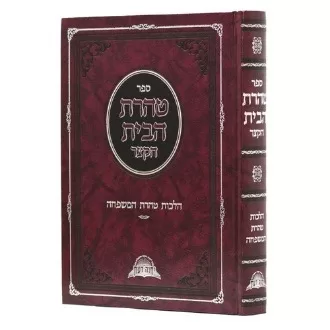

Rav David Yosef wrote a one volume summary of his father’s sefer in which every halacha has a citation to its source in Taharat HaBayit. It was originally called Taharat HaBayit HaKatzar and printed in the back of Taharat HaBayit. Then, it was published separately as Torat HaTaharah but has recently been renamed back to Taharat HaBayit HaKatzar.
Hacham David was the one who typed up the original Taharat HaBayit. Hacham Ovadia would himself go give Hacham David’s public shiurim, so Hacham David wouldn’t have to stop typing. Certainly, he knows his father’s sefer in and out.
This sefer is incredibly clear, as it details every single parameter of every single case. So if Halacha #1 was about how “A + B + C = X” and Halacha #2 is just a slight modification, it will explicitly state all the parameters “A + B + D = Y” and not just continue “if D instead of C then Y.”
This is obviously super helpful in making sure one does not intuit the wrong pesak from a basic paragraph that doesn’t spell everything out. On the other hand, when preparing every month for the mikveh, it can be a huge time drain to review every single halacha in every single scenario when all you really want is a refresher. Similarly, when preparing a Chattan who already has quite a bit on his mind, going through every detail risks losing his focus. At times, keeping things simple and showing where to look up the details can be the better option. וחכם עיניו בראשו.
That said, there are a couple of shorter, more “get-by” presentations of more or less the same halachot that may be more helpful at the teaching and review stages. See below.
One should beware that there are a number of places that Hacham David’s articulation differs slightly but noticeably from that of his father. ודי למבין.[1]
Hacham David’s sefer is readily available in Hebrew and in English.
3. Laws of Niddah
Rav Yonatan Nacson
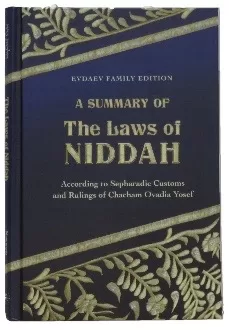
My friend Rav Yonatan Nacson has been learning in Yehave Da’at’s Kollel Aram Soba for over a decade and has written a number of helpful English books on Sepharadi Halacha. He has plenty of “Beis Hora’ah” shimush through his app InstaRabbi and is a well tapped resource of Hacham David’s publishing house.
Rav Nacson’s Laws of Niddah is a great, concise Kitzur halachot of all the necessary Halachot according to Hacham Ovadia with great footnotes to all the Hacham Ovadia Torah among other popular Sefarim. He intentionally doesn’t spell out every detail like Hacham David, so the sefer is much more manageable to get through. Plus, he includes sample calendars and charts to better grasp the concept of vestot. Finally, he has a review test at the end to make sure you didn’t miss anything.
The book can be read cover to cover on a long Shabbat afternoon . It’s a great “get-by” sefer for preparing couples for marriage.
The sefer is available from Mekor Judaica.
4. Taharat Haim טהרת חיים: Laws and Customs of Family Purity in Accordance with the Sephardic Jewish Tradition
Rav Mosheh Aziz
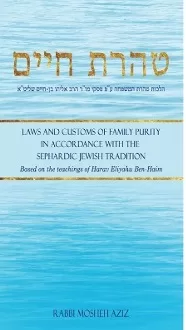
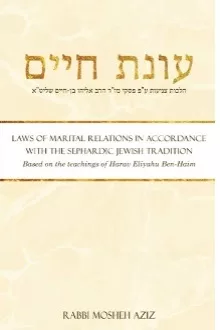
My friend Rav Mosheh Aziz is the Talmid Muvhak of Hacham Eliyahu Ben-Haim, the chief rabbi of the United Mashadi Jewish Community of America. As a rabbi in the Mashadi community, Rav Aziz and other community members have established a system of mandatory premarital classes for their community, and his book has become the standard text. He has plenty of experience guiding couples before and after marriage in this field, with the support of Hacham Ben-Haim, as well as specific training from Machon Puah.
Taharat Haim is a well written “get-by” sefer that has everything a Sephardic couple needs to know, based on Hacham Ovadia’s Sefarim and the shiurim of Hacham Ben-Haim, with sources and some further elaboration in the endnotes. There are also general introductions expressing Torah-true values of marriage and taharah for the couple to imbibe. One can easily read the sefer (minus turning to the endnotes) over the course of a few hours.
The sefer is published by KDP (Kindle Direct Publishing) and readily available on Amazon.
Rav Aziz also wrote Onat Haim עונת חיים: Laws of Marital Relations in Accordance with the Sephardic Jewish Traditionas a companion volume to teach the practical halachot of what is and is not permissible in the bedroom.
5. Darkei Taharah
Hacham Mordechai Eliyahu
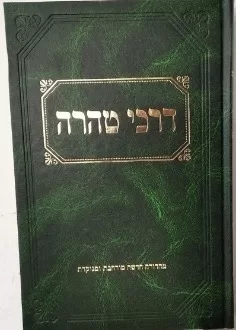
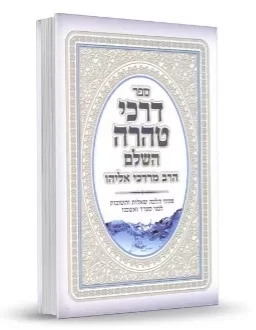
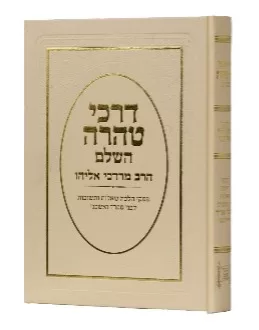
Hacham Mordechai Eliyahu was a dayan in the Beit Din HaGadol in Yerushalayim, Rishon LeTzion, Mekubal, and Tzaddik Yesod Olam who taught laymen and scholars alike for much of his life. Continuing in the path of the Ben Ish Hai, he wrote a sefer of his Niddah shiurim for the masses called Darkei Taharah, which presents the basic halachot spelled out extremely clearly and in great detail. Certainly, in America, he is not as popular, but in the Dati Leumi velt in Eretz Yisrael, he is a major player. Unlike the Yosef family’s Sefarim which are mostly cut and dry halacha, he explains the ideas beautifully.
I emphasize his fidelity to the Ben Ish Hai, as, unlike Hacham Ovadia (see above), the Ben Ish Hai and, subsequently, Hacham Mordechai Eliyahu, advocate for everyone to follow virtually every humra – both in nigleh and nistar – and only seek a kullah when necessary. As such, the lines between Ashkenazi and Sepharadi pesak are blurred, as the Rama’s stricter view is often the one adopted.
The sefer also includes a section on Hilchot Yichud and on Hilchot Tzeniut in the back, a topic not really addressed by contemporary posekim publicly.[2] Of course, he does not go for the kullot that other contemporaries present and sides like the stricter views on these issues. Nevertheless, having the topic available underscores the importance of keeping the halacha.
In recent years, some Rabbanim (even those who knew him) lament how people use his sefer, as it not uncommonly leads to being to Machmir at the cost of Shalom Bayit. Some also find issue with the introduction’s claim to be intended for all strains of the Jewish people, given how it doesn’t do enough differentiation based on those lines. One rabbi even compiled a list of all the differences between Hacham Ovadia and Hacham Eliyahu, and it was published by Machon Puah. It should not be surprising that the author was not such a writer in general and only really published Kitzur Sefarim in his lifetime. There’s also an article about the sefer in HaMa’ayan (Nissan 5778).
Upon his passing, a new edition was issued with nicer layout, nekudot, and footnotes including piskei halacha, letters, and clarifications from the author himself. It is available for purchase in Hebrew, English, and Spanish and for free reading on HaRav.org. There’s also a Kitzur version available, but I’ve never opened it. Honestly, just get the real thing.
6. Avnei Shoham
Rav Moshe Paniri
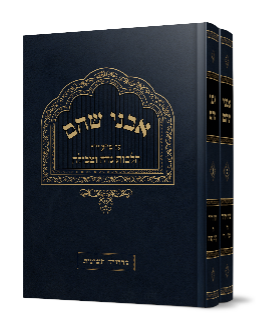
One day in Porat Yosef, an Avrech who was learning Hilchot Niddah beIyun approached Hacham Ben Tzion Abba Shaul, the Rosh Yeshiva, with a number of questions, to which the Rosh Yeshiva asked back “tell me, are you writing a sefer halachot?” The Avrech admitted that he was and asked the rebbe to review it, which the Hacham did, and eventually the sefer Avnei Shoham was published by a young Moshe Paniri (from Rabbenu HaOhr Letzion vol. 2 pg. 98; Hakdama to Avnei Shoham).
Rav Paniri is the head of a network of Batei Hora’ah “Afikei Mayim” and the author of a number of important books of Halacha. Important on their own and also because they bear the views of Hacham Ben Tzion and other gedolim. In general, he reportedly tries to keep to the middle path between Hacham Ben Tzion and Hacham Ovadia.
Today in its 10th edition, Avnei Shoham is a well-known sefer, made up of two thick volumes. It’s extremely kedai to keep at hand, as he discusses many issues in depth al seder Shulchan Aruch and has the shoulders – his own and those of his rebbe – to back his pesak.
I’ve been asked a number of times what the go to sefer should be for people who wish to follow Hacham Ben Tzion, and Hacham Gideon Ben Moshe, one of his Talmidim Muvhakim from the end of his life, told me Avnei Shoham is the closest. Hacham Gideon literally wrote the first volume of Ohr LeTzion for his rebbe and assisted with the later volumes, as well, before Hacham Ovadia took him under his wing. I think he’s a pretty reliable source.
What happened when the new Yalkut Yosef was published is, therefore, no surprise. See below.
The sefer is available at ShopEichlers. For readers not yet ready for hefty Sefarim like this, the Kitzur version, Afikei Mayim, should be just fine. They’re also available on Otzar HaChochmah.
7. Yalkut Taharah (Yalkut Yosef)
Hacham Yitzchak Yosef
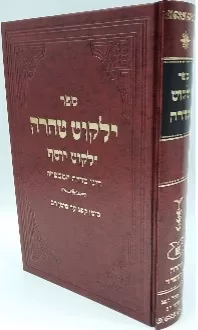
The Rishon Letzion, Hacham Yitzchak Yosef, just published the newest volume of Yalkut Yosef, called Yakut Taharah. The sefer has already caused waves among Rabbanim in Eretz Yisrael and has recently arrived in America.
There are a number of different sections to this 950-page sefer.
The introduction rehashes much of the classic Rav Ovadia-Rav Yitzchak Yosef halachic philosophy of primacy of the Shulchan Aruch over the Ben Ish Hai and other authorities – Sephardic communities of every time and place have clearly accepted Shulchan Aruch completely, Rav Yosef Karo is the Mara DeAtra of Eretz Yisrael, Iraqi Jewry was influenced by Ashkenazi rabbis who came a couple centuries ago after a plague wiped out all its Hachamim, and Kabbalah should not supersede Halacha. He presents much praise for the Ben Ish Hai and then quickly summarizes all the places where the Ben Ish Hai disagrees with Maran in Hilchot Niddah specifically and then runs through many more of his pesakim as well – 122 examples altogether.
For those already acquainted with this philosophy, this is a fantastic and up to date summary with some nice stories; for those who haven’t seen it yet, this is an excellent gateway into Rav Ovadia’s philosophy of Halacha. Rav Ovadia faced fierce opposition to his views back in the forties and fifties for going against the tide and ruling against the Ben Ish Hai in the face of the latter’s students who were all over the Porat Yosef/Geulah scene and were physically and politically aggressive against him. Today, he continues to face opposition from the more hareidi camp (i.e. Hacham Yaakov Hillel shalita claims Rav Ovadia’s pesakim are not for bnei torah) who think he doesn’t give enough credit to the Ben Ish Hai and minhag. See the kuntres Yirat HaHora’ah published in the back of the Ben Ish Hai’s Mekavtziel(2013) for some anti-Rav Ovadia propaganda and more examples. Rav Yitzchak explicitly and implicitly calls out these camps, as usual. Hacham Ben Tzion’s Talmidim also get a shoutout for positioning Hacham Ben Tzion to be an anti-Rav Ovadia guy, but Rav Yitzchak testifies that his personal interactions with Hacham Ben Tzion prove otherwise.
Afterwards, there’s a brief survey of the basic halachot for a new couple to know (20 pages of 127 Halachot), which was originally printed in 1985 and is now updated and reprinted. Following that is the regular Yalkut Yosef style sefer al seder Shulchan Aruch (Yoreh Deah 183-202) which is all the Rav Ovadia Torah al seder Shulchan Aruch with expanded mekorot and applications (but not on every single nekudah). He spends much time defending his father’s pesakim and biurim from other contemporaries, such as Rav Paniri in Avnei Shoham and Rav Shlomo Zafrani[3] in Ein Yedid.[MMD5]
Finally, the volume concludes with letters from Rav Yitzchak Yosef on various Niddah issues and critical reviews of other Sefarim (250 pages), plus some letters from Rav Ovadia. Many of these have been printed elsewhere, but they’re nicely collected (probably by his assistant Rav Daniel Ozen, Rav Yitzchak Yosef’s righthand man and owner of https://moreshet-maran.com/).
The letters are apparently quite juicy, as he offers a running commentary on Darkei Taharah (125 comments), 31 attacks on Rav Paniri’s Avnei Shoham, etc. The goal of many of the critiques on younger, more contemporary figures is apparently to uphold the correct approach to halacha (i.e. Hacham Ovadia, not Hacham Ben Tzion), and also to put down anyone who misquotes Hacham Ovadia differently than is written in the Sefarim (i.e. Rav Paniri and others a number of times based on hearsay). Needless to say, Rav Paniri’s Beit Hora’ah’s WhatsApp groups as well as other rabbi groups have been reportedly alit with conversation about these latest discoveries. My information comes from various contacts in the holy land.
The sefer is available in Seforim stores now and belongs on every Kollel and rabbi’s bookshelf.
8. Rose of the Valley (שושנת העמקים), The Laws of Family Purity According To The Sephardic Custom
Rabbi Rahamim Shaul Sultan
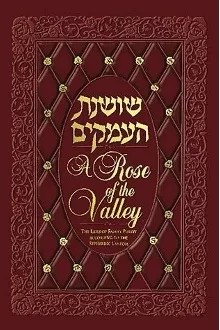
The Syrian community enjoys its own Minhagim in general and in Hilchot Niddah in particular. Not everything is straight Hacham Ovadia Yosef. As such, one of its constituents, Rabbi Rahamim Sultan, a long time Lakewood resident, put out a gorgeous sefer called Rose of the Valley. I’m not a member of this community, but from what I understand, it’s pretty well accepted.
The sefer is thorough, and well written with full paragraphs for each Halacha, and is very much a joy to read. There’s also a quick summary at the end for newlyweds to review.
The sefer is available from Feldheim.
9. Orot HaTahorah
Rav Zechariah Ben Shlomo
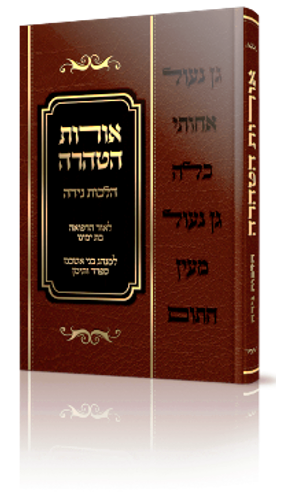
While I spent two years or so in Yeshivat Shaalvim, I became acquainted with Rav Zechariah Ben Shlomo, a Teimani Posek and author of a well-received Sefer Hilchot Tzava / Orot HaHalacha, an extremely thorough Kitzur sefer for every soldier and rav-tzva’i to have handy. Rav Ben Shlomo literally fields thousands of she’elot a week singlehandedly via WhatsApp to people from all across the religious spectrum (no, he does not encourage marot over WhatsApp) and continues to deepen his learning of Niddah as every new question arises and new sefer comes out despite his decades of experience. I’m very much a beneficiary of his teaching.
Rav Ben Shlomo may be Teimani, but his sefer Orot HaTahorah is meant for Ashkenazim, Sepharadim, and Teimanim. He covers the halacha for all three camps and includes citations to each group’s contemporary gedolei haposkim, discusses many modern-day medical procedures, and finishes off the sefer with general Klalei Hora’ah for every rabbi to study and rule by. Rav Paniri’s Beit Hora’ah uses his sefer regularly.
The sefer is available in Eretz Yisrael (and on Otzar HaChochmah if you need).
Other Sefarim
עשות ספרים אין קץ
There’s no end here, so I’ll end it myself. That said, there are a few more out that to just know of their existence.
Taharat Yosef
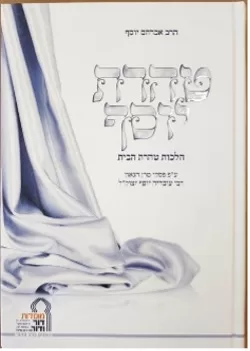
Rav Avraham Yosef also wrote a simple sefer on Niddah called Taharat Yosef for the less educated masses, but that is not as popular and is often confused for this one (at one point their covers were similar). It’s been printed in Hebrew, English, and Spanish. I have never opened it before, so I can’t vouch for it more than that. From the pictures on the internet, it seems to be a simple, written out version of all the Rav Ovadia Torah. Sort of like Darkei Taharah but even lighter.
Talelei Tohar
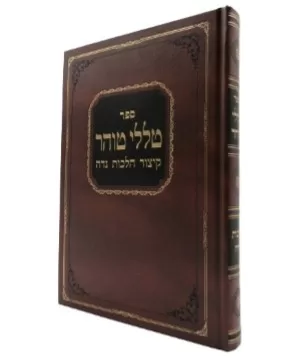
Rav Tal Doar is a moreh hora’ah living in Sanhedria Murchevet and learned by Hacham Ben Tzion. It seems his sefer was commissioned to be the right-wing alternative to Hacham Ovadia: it’s certainly more machmir. More than that, perhaps someone else can fill me in. His sefer is available in Hebrew.
Even More
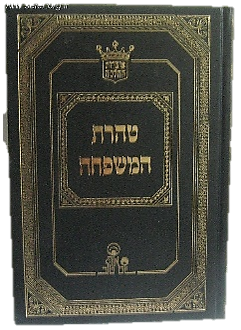
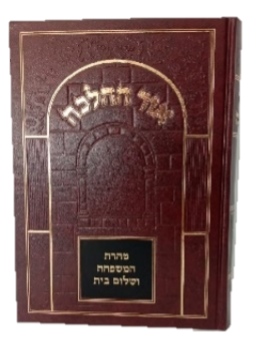
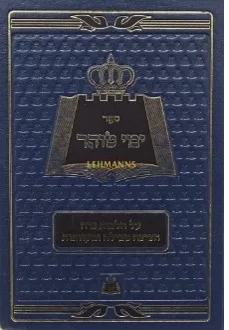
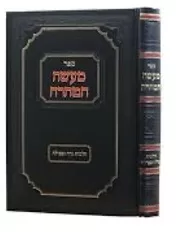
There are certainly more books out there, but I either haven’t learned them or didn’t find them to bear much of a contribution over those already mentioned. Rav Yaakov Shkenazi, Rav Yenun Yonah, Rav Aharon Zakkai, and others all have Sefarim, but my superficial perspective tells me they fall into this category. Similarly, there’s a sefer Ohr HaHalacha, but that’s generally just a likut, if I understand correctly.
Rav Eliyah Refael Cohen, married to a granddaughter of Hacham Ovadia, has a sefer Maaseh HaTaharah, the style of which is very much to mimic Orchot Shabbat in terms of organization and blending comprehensiveness with depth into contemporary poskim, as he states in his Hakdama to Maaseh HaShabbat vol. 1. In other words, this likut seems to add user friendliness and his he’arot on these sugyot. The former is great, but the latter is not necessarily what the lay learner is looking for.
Most of these are widely unknown, unused, and/or unavailable. Yes, they exist, but you’re better off picking a different option.
[1] One Talmid told me the author does not expect his words to read with such exactitude.
[2] Due to the lack of Torah from the Yosef family in this field, I once asked Rav Avraham Yosef to clarify a machloket between the Chida and Ma’amar Mordechai in this regard. The Chida was mekatzer and somewhat soter himself, and I wanted a hachra’ah. His response was “אבי מו”ר מרן זצ”ל הנחה את אחי ידידי הרב דוד שליט”א לדלג ולא לכתוב על זה. וכשמו כן הוא צניעות. אם החיד”א קיצר אנחנו נאריך? עיין ותבין.”
[3] Rav Yitzchak Yosef’s attitude towards whom is already not positive.



One Response
Thank you, Rebbe!